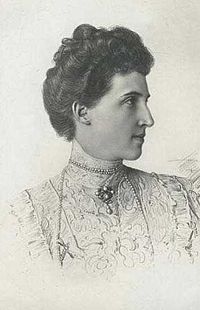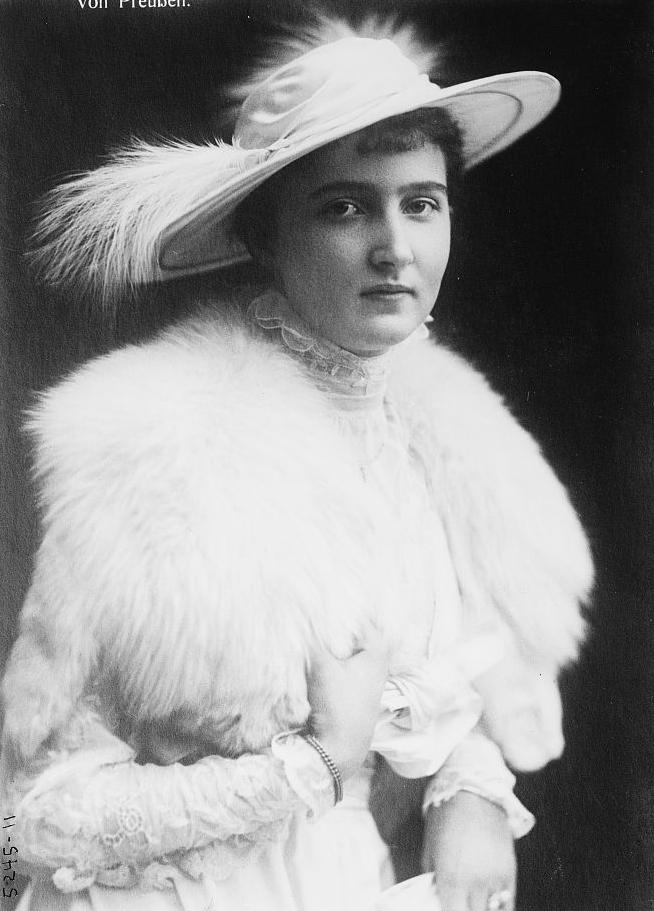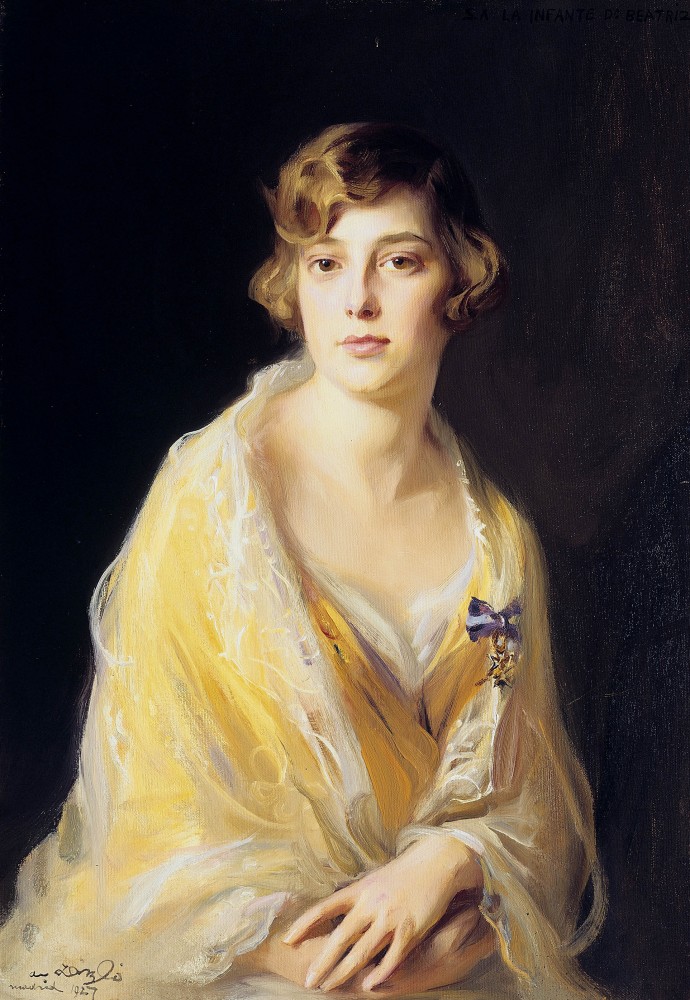 |
| Duke Eduard of Anhalt (1861-1918) |
 |
| Princess Luise of Saxe-Altenburg (1873-1953) |
On 17 April 1903, Prince Eugen Friedrich Ernst August Heinrich Adolf Aribert of Anhalt, Duke of Saxony, Count zu Askanien, was born at Dessau, the capital of the Duchy of Anhalt. Eugen was the fifth child and third son of Duke Eduard of Anhalt (1861-1918) and Princess Luise of Saxe-Altenburg (1873-1953). Eduard and Luise had married in 1895 at Altenburg; the couple had six children, of whom four survived until adulthood: Princess Friederike (born and died in 1896), Prince Leopold (1897-1898), Princess Marie Auguste (1898-1983; married firstly to Prince Joachim of Prussia, then to Baron Johannes-Michael von Loën), Prince Joachim Ernst (1901-1947; Duke of Anhalt; married firstly to Elisabeth Strickrodt, then to Edda Marwitz), Prince Eugen (1903-1980), lastly, and Prince Wolfang (1912-1936). Duke Eduard and Duchess Luise of Anhalt were divorced in 1918, before Eduard's death. Their eldest surviving son, Joachim Ernst, was the last reigning Duke of Anhalt. He lost his throne in 1918 when his uncle and regent, Prince Aribert, abdicated on his behalf. Aribert was the ex-husband of Princess Marie Louise of Schleswig-Holstein, granddaughter of Queen Victoria; the couple's divorce in 1901 sparked rather a scandal.
 |
| Princess Marie Auguste of Anhalt (1898-1983) |
 |
| Duke Joachim Ernst of Anhalt (1901-1947) |
 |
| Prince Eugen of Anhalt (1903-1980) |
 |
| Prince Wolfgang of Anhalt (1912-1936) |
In January 1928, Prince Eugen and his sister Princess Marie Auguste, Baroness von Loën, took their older brother Duke Joachim Ernst to court at Dessau. The siblings requested that Joachim Ernst, who was described as "an art connoisseur and a theatrical producer," should be placed under a trusteeship by the court. Joachim Ernst contested that his sister Marie Auguste was unjustly seeking damages against him, after he had agreed (but failed) to give her a monthly allowance of $500. The duke further stated that his brother Eugen was only seeking additional monetary gain, as Joachim Ernst alleged that Eugen had already received certain sums of money from the Anhalt estate.
 |
| Duke Joachim Ernst of Anhalt and first wife Elisabeth Strickrodt |
At this time, Joachim Ernst was married to his first wife, Odile
Elisabeth Strickrodt (1903-1971), a former actress. Elisabeth was granted the title Countess of Ascania upon her marriage. Joachim Ernst and Elisabeth divorced in 1929; later that same year, Joachim Ernst remarried to Editha "
Edda" Charlotte Wilhelmine Marwitz (adopted daughter of Bertha von Stephani, whose surname Edda used afterwards). Five children were born during the course of the union of Joachim Ernst and Edda: Princess Marie Antoinette "
Alexandra" (1930-1993), Princess Anna Luise (1933-2003), Prince Friedrich (1938-1963), Princess Edda (b.1940), and Prince Eduard (b.1941). Duke Joachim Ernst died on 18 February 1947 at Buchenwald as a Russian prisoner of war.
 |
| Duke Joachim Ernst of Anhalt |
 |
| Duchess Edda of Anhalt |
 |
| The Ducal Children: Alexandra, Anna Luise, Friedrich, Edda, and Eduard of Anhalt |
Prince Eugen married
Anastasia Marie Therese Karoline Jungmeier (25 July 1901-19 February 1970) on 2 October 1935 at Munich. Anastasia was the daughter of industrialist Max Jungmeier and his wife Anastasia Steiner. Eugen and Anastasia of Anhalt had one child: Princess
Anastasia Luise Alexandra Elisabeth Jutta Sybille Marie-Auguste Henriette, who was born at Regensburg on 22 December 1940.
 |
| Prince Eugen of Anhalt and Anastasia Jungmeier on their wedding day |
After it became known that his brother Joachim Ernst had died, Prince Eugen staked his claim as Head of the Ducal House of Anhalt. This occurred despite the fact that two sons were born during the marriage of Joachim Ernst and Edda Marwitz-von Stephani. However, some genealogists have raised doubts about the paternity of Friedrich, Edda, and Eduard of Anhalt, Eugen's nephews and youngest niece. Princess Alexandra, Eugen's niece and Eduard's sister, went on the record in 1990 and claimed that her "
half-brother" was actually the son of Heinrich Himmler; Eduard dismissed his sister's words as being part of a smear campaign. The reasoning behind genealogists' doubts about the paternity of Eduard (and his late brother) hold their grounding in the fact that Joachim Ernst, their legal father, was in a concentration camp beginning in 1938 and until his death in 1947: thus, he would not have been in a position to sire children with his wife during that time. Prince Eugen maintained his claim to the Headship of House Anhalt until his death.
 |
| Prince Eugen of Anhalt |
Prince Eugen and Princess Anastasia of Anhalt were both able to witness the marriage of their daughter in 1962. Anastasia Luise civilly married Prince Maria Emanuel of Saxony (1926-2012) on 22 June 1962 at La Tour de Peilz, Switzerland. The couple's religious wedding took place the following day. Maria Emanuel worked as a banker in Switzerland. He was also a painter of talent, and several exhibitions were held that displayed his work. In this vein, he shared a bond with his mother-in-law, Anastasia, who was also a noted painter. The princess signed most of her works as "Anastasia Young [Jung]."
 |
| Princess Anastasia Luise of Anhalt and Prince Maria Emanuel of Saxony after their civil wedding |
 |
| Anastasia Luise and Maria Emanuel after their religious marriage |
Upon the death of Prince Friedrich Christian of Saxony in 1968, his son Maria Emanuel succeeded as the Head of the Royal House of Saxony and assumed took the title Margrave of Meißen. Anastasia Luise and Maria Emanuel were married for fifty years when the Margrave of Meißen died on 23 July 2012. The couple did not have children. Maria Emanuel was succeeded as Head of House Saxony by his nephew and adopted son Prince Alexander, Margrave of Meißen, who is married to Princess Gisela of Bavaria. Princess Anastasia Luise, Dowager Margravine of Meißen, is quite close to her nephew and adopted son Alexander, as well as his family, who all embody the future of the Royal House of Saxony.
 |
| Prince Maria Emanuel and Princess Anastasia Luise, Margrave and Margravine of Meißen |
 |
Maria Emanuel and Anastasia Luise of Saxony with King Simeon and Queen Margarita of Bulgaria
Photograph (c) Presse-Foto-Seeger |
Meanwhile, Princess Anastasia of Anhalt died at Vevey on 20 February 1970, aged sixty-eight. The princess was an artist of some note, and her passing was mentioned in several international papers. Prince Eugen survived his wife by ten years: he died at La Tour de Peilz on 2 September 1980. Eugen of Anhalt was seventy-seven.
 |
| Obituary of Princess Anastasia of Anhalt |
Princess Anastasia Luise of Saxony, Dowager Margravine of Meißen, lives today at the Villa Ascania in Switzerland.
 |
| Princess Anastasia Luise of Saxony with Prince Alexander and Princess Gisela of Saxony with their children |







































.jpg)










.jpg)


